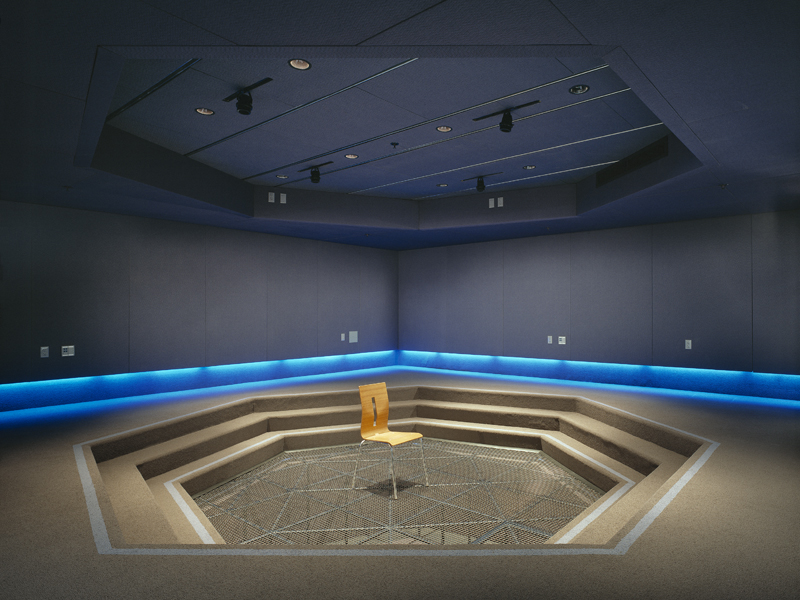Listening Room Specs
From CCRMA Wiki
Welcome to the Pit Page
written by Jason Sadural (jsadural@ccrma.stanford.edu) comments and suggestions always welcomed
This page discusses the room dimensions as well as the the process of calibrating the spherical VBAP configuration. It will also discuss the equipment and software used to operate sound as well as how to configure and save settings for your personal needs. If you move any speaker in the room you will be personally responsible to recalculate and recalibrate speaker configuration (in other words "DON"T DO IT!!!").In the future we hope to update this page with a new wave field synthesis installation. In 2008 we will be implementing a new system formally titled Openmixer.
- Room Dimensions
- 277inches x 292 inches x 86 inches(height)
- There exists a heptagon in the center with 3 steps downwards to a cage in the middle
- Height of each step = 5.5 inches
- Length of step = 11.75 inches
- Length of side of Heptagon at top = 84 inches (same as top)
- Depth of indentation in ceiling = 15 inches
- Length of side of Heptagon at cage(bottom) = 63 inches
- Depth to bottom of cage = 41 inches
- Closest point of Heptagon to wall = 51 inches
- Equipment and software
- Samsung 17 inch monitor
- Linux box
- RME Hammerfall DSP Digiface
- Tascam TDIF-1/ADAT interface format converter
- Tascam DM-3200
- 5.1 DVD player
- 8 Mackie HR824
- 8 Mackie HR624
- AKG C-414 Mic/Stand/adapter
- ALSA HDSP
- Jack
- Before beginning, create your own project by clicking "alt-Project" and cursor down to "store as." Name your project using the Dial and the enter key. After doing so, follow instructions and store at the end of calibration. Please use current calculations of speaker configuration instead of repositioning speakers.
- Current speaker configuration
- speakers 1 is on channel 1 assigned to output 7, speaker congiguration is coutner-clockwise starting at 0 degrees
- speakers are in octagonal setup with speakers 92 inches apart
- Distance to sweetspot from each horizontal speaker is 120.205 inches
- Verticle speakers distance will be termed in counterclockwise order PhiU1(upper1 azimuth), ThetaU1(upper1 angle), ru1(upper1 distance) and so on(all in degrees).
- Speaker 1 horizontal = 120.205
- ThetaU1 = 46.123 ; PhiU1 = 34.582; rU1 = 88.8147
- ThetaU2 = 134.578; PhiU2 = 35.213; rU2 = 87.2017
- ThetaU3 = 225.119; PhiU3 = 29.898; rU3 = 90.2783
- ThetaU4 = 328.552; PhiU4 = 31.448; rU4 = 91.3406
- ThetaD1 = 46.429 ; PhiD1 = -61.214; rD1 = 95.1767
- ThetaD2 = 135.557; PhiD2 = -60.980; rD2 = 95.6595
- ThetaD3 = 235.089; PhiD3 = -43.200; rD3 = 89.9286 (Possible Error)
- ThetaD4 = 317.181; PhiD4 = -55.781; rD4 = 98.3265
- Speaker Positioning : In calibration of the speakers, I used a T-square, laser Line tool, Wire, tape measure, and Protractor. I made sure that the sweet spot would be intuitive upon placing the seat into the center of the Pit.
- Use obvious methods to align horizontal speakers in an octagon at a arbitrary distance measured from the center of cage.
- Measure 3 distances from each verticle(above/below) speaker to 3 different horizontal speakers
- Use trilateral calculation to solve xyz position in space
- Use octagon properties to perform coordinate transformation in order to find position from sweet spot(center of octagon)
- PD patch in which calculates intersecting spheres located through ccrma-gate at /jsadura/trilateration
- Speaker Calibration
- settings: Acoustic Space "B"half; Low Freq 37Hz; High Freq 0Hz; Power Mode ON
- Make sure all bus and gain settings are equal on mixer
- Adjust gain on speaker and use Pink noise to calibrate equal SPL levels at the sweet spot one at a time
- Time Delay
- Calculate distance to verticle speakers (R) from trilateration page and find the difference in distance to horizontal speakers
- At a 44.1kHz sample rate, divide distance in inches by 0.3 to calculate samples of delay
- on Tascam DM-3200 mixer select "Module" on top right and move cursor down to Delay
- Hold shiFt while turning third knob for smaller increments of delay in samples.
